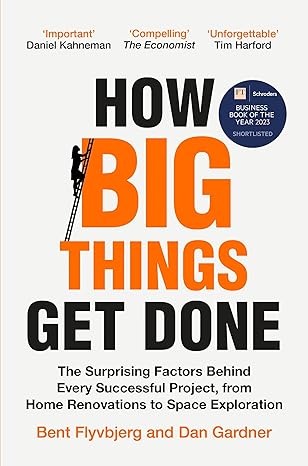As an Amazon Associate I earn from qualifying purchases.
Why it matters now: As the world races to build the clean energy infrastructure needed for net zero by 2050, project failures could derail our climate goals. How Big Things Get Done reveals why 99.5% of major projects fail—and how to join the successful 0.5%.
Introduction & Overview
How Big Things Get Done (2023) by Bent Flyvbjerg, a leading expert on megaproject management, and journalist Dan Gardner examine why delivering large projects is so difficult, with crucial lessons for anyone working on the energy transition.
Building from a database of over 16,000 projects globally, the authors reveal patterns of success and failure that hold vital lessons for achieving our low-carbon future.
Key Insights
The Iron Law of Megaprojects: Flyvbjerg’s research reveals a shocking reality: 99.5% of major projects fail to deliver on time, on budget, and with promised benefits. Only 0.5% succeed fully, highlighting the immense challenge facing anyone trying to deliver complex change.
Think Slow, Act Fast: Contrary to the rush to “just start,” successful projects require meticulous upfront planning followed by rapid execution. The Empire State Building and Pixar films exemplify this approach. Failed projects like California’s high-speed rail follow the opposite “think fast, act slow” pattern.
Reference Class Forecasting: Project planners must abandon illusions of uniqueness by using data-driven reference class forecasting, estimating costs and duration based on historical data from similar projects. This decision hygiene method, endorsed by Daniel Kahneman, helps manage the unknown unknowns that plague big projects.
Modularity Enables Clean Energy Success: Wind and solar succeed because they use modular, repeatable components that enable learning-by-doing and predictable costs. Nuclear power faces negative learning, spiraling costs due to bespoke, one-off designs. This explains why renewables consistently rank among the most reliable project types.
Practical Takeaways
- Plan through experimentation: Use iterative approaches like Pixar’s to reveal risks early and develop robust, tested plans
- Embed decision hygiene: Incorporate reference class forecasting and premortems to challenge optimistic assumptions
- Design for modularity: Prioritise modular, scalable architectures to harness learning curves and reduce extreme risks
- Minimise project duration: Reduce exposure to unpredictable disruptions by closing the “window of doom” quickly
- Master stakeholder dynamics: Build experienced, aligned teams and manage power dynamics proactively
Who Should Read This
This book is essential for policymakers, infrastructure and energy leaders, sustainability planners, and climate activists. Its insights are especially vital as governments and corporations mobilise trillions in climate investments—showing how success is attainable with the right approach.
Final Thoughts
How Big Things Get Done excels at combining empirical rigour with accessible storytelling. Its evidence-based challenge to project over-optimism is a much-needed corrective. While some readers may want deeper exploration of social equity dimensions, the book’s focus on delivery mechanics is compelling and practical.
If you care about climate progress and want to understand how to reliably deliver the monumental efforts our future demands, this book arms you with proven tools to tilt the odds of success in your favour.
